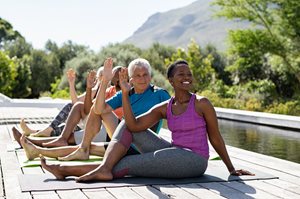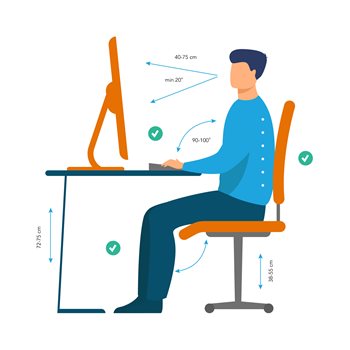NEWS
Wednesday 23 November 2022
Musculoskeletal conditions have been widely talked about in the last few years. The switch to home and hybrid working set-ups, sedentary lifestyles during COVID-19 lockdowns and more have caused a rise in back, neck and joint pain, in particular.
I n our Global Private Healthcare Landscape report, we analysed medical claims data from our multinational clients and found that musculoskeletal claims are now the top cost driver for employers.1
n our Global Private Healthcare Landscape report, we analysed medical claims data from our multinational clients and found that musculoskeletal claims are now the top cost driver for employers.1
Do you want to know a little more about posture and how you can help your people improve theirs? Here’s Arpit Khemka, CEO at SimpleTherapy,2 to explain.
What is posture?
Before we can help you correct your posture, it’s important to understand what it is. Posture is the way your body holds itself when sitting, lying down, standing, or moving. Good posture is an indication of proper musculoskeletal alignment. This means, when you have good posture, your muscles and bones are in balance and the body is symmetrical. Asymmetry is the main cause of poor posture.
How do you know if you have ‘poor’ posture?
There are five main indicators of posture that can help you recognise where improvements may need to be made.
Lordosis – This is where the spine curves significantly inward at the lower back. This can cause muscles in the lower back and hip flexors to become extremely stiff and tight, while the abdominal muscles and hip extensor muscles are at risk of becoming weak.
Flat back – This occurs when there is an abnormal curvature in the thoracic spine (mid-back) which creates a reduction in the natural curve of the lumbar spine (low back). This creates a posterior pelvic tilt resulting in overly tight upper abdominal muscles and hip extensors while the lower back and hip flexors are at a greater risk of becoming weak.
Swayback – This is where exaggerated curvature of the lower back occurs resulting in a pronounced forward head tilt. This can create pain and weakness in the lower back, giving off the appearance of leaning back while standing.
Kyphosis – This is characterised by an abnormally rounded curve in the upper back. This is becoming more and more common and is highly associated with sitting and desk/office work. This can give an appearance of a hunchback. It results in extremely tight muscles in the traps, (on top of the shoulders) pectorals (chest muscles), and lats (located on the sides of the upper back).
 Forward head – This occurs when the cervical spine (neck) loses its natural curvature. This is also highly linked to desk jobs that involve long periods of sitting and staring at computer screens. This can result in tight cervical extensors and scalene muscles (located in the front of the neck).
Forward head – This occurs when the cervical spine (neck) loses its natural curvature. This is also highly linked to desk jobs that involve long periods of sitting and staring at computer screens. This can result in tight cervical extensors and scalene muscles (located in the front of the neck).
Did you know a forward head tilt can add up to 30 pounds or 13kg of unnecessary and avoidable pressure on the cervical spine?
What are the benefits of good posture?
Good posture is essential in ensuring that our bodies are functioning as efficiently as possible. It can affect organ placements and efficiency, such as lung capacity and even bowel movements.
Good posture is also an essential factor in preventing or limiting back pain. Since most posture deviations occur in the spine, pain in the back, neck, hip or shoulder might well signal an issue.
Good posture allows the body to move efficiently and efficient movement can help prevent muscle fatigue, improve balance, improve muscle strength and allow better athletic performance.
How we can all maintain or achieve good posture (and how you can help your people)
Exercise
 Don’t worry! Most of us have some form of deviation or misalignment. Exercise is not only the most efficient way to correct bad posture but also when done properly, its benefits can last the longest. Through exercising and stretching, you are restoring movement patterns, activating weak muscles and retaining symmetry throughout the body. This is essential in preventing injuries and alleviating current discomforts and injuries.
Don’t worry! Most of us have some form of deviation or misalignment. Exercise is not only the most efficient way to correct bad posture but also when done properly, its benefits can last the longest. Through exercising and stretching, you are restoring movement patterns, activating weak muscles and retaining symmetry throughout the body. This is essential in preventing injuries and alleviating current discomforts and injuries.
What employers can do: encourage your employees to exercise regularly. It might sound simple, but in the world of flexible, hybrid and home working, encouraging people to take time out of their day to exercise could be important. Not commuting can mean not moving enough. You could also consider employee challenges too – why not set a team step goal, distance covered or active minutes challenge.
Habits
Consistency is the biggest factor when it comes to improving and maintaining good posture. A single day of exercise is not going to correct years of sitting at a desk or driving! It requires an investment of time, effort and consistency. It is also important to be mindful of your body at all times. If you catch yourself slouching, fix it! If you’re sitting with your legs crossed, uncross them! Small interventions like this can help build positive habits moving forward that can have a major impact on your posture in the future.
What employers can do: encourage good posture in the office and the home office. Consider setting policies where meetings end after 25 or 55 minutes to allow time for people to stretch or get away from their desks. Post pictures of good posture on your intranet or office noticeboards so everyone knows what it looks like and is reminded to practise good habits.
Change your environment
Your work setting can have a big impact on your posture. As computer usage, phone usage, and jobs that are desk-based continue to increase, the importance of postural awareness will become ever-more important. Using phones, tablets and computers has become such a part of normal life they are now difficult to avoid. Here are some suggestions to help combat poor posture:
- use a chair with lower back and neck support
- when seated ensure your desk is at elbow level and your computer screen is at eye level
- avoid crossing your legs
- avoid leaning into your computer screen
- sit up straight and keep core muscles activated.
What employers can do: ensure your people have an ergonomic setup, both in the workplace and at home. Encourage people to move regularly – setting times to stand up, move and change position are important. For those not in desk-based roles, can you do more to ensure people aren’t in uncomfortable positions for too long without a break?
Thanks for the insights on posture Arpit. If you want to find out more about posture and how SimpleTherapy’s musculoskeletal programme could benefit your people, please contact your MAXIS GBN representative.3
2 SIMPLETHERAPY, INC. incorporated and registered in DELAWARE, USA whose registered office is at 39180 Farwell Drive, Suite 110, Fremont, California, USA 94538
3 MAXIS GBN may receive fees, commissions and/or other remuneration from third parties in connection with the services we carry out for you.